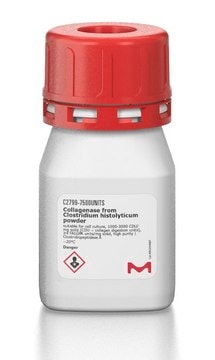V900893
Collagenase aus Clostridium histolyticum
Type IV, Vetec™, reagent grade, powder, ≥160 CDU/mg solid
Synonym(e):
Clostridiopeptidase A
About This Item
Empfohlene Produkte
Biologische Quelle
Clostridium histolyticum
Qualität
reagent grade
Produktlinie
Vetec™
Form
powder
Spezifische Aktivität
≥160 CDU/mg solid
Methode(n)
cell culture | mammalian: suitable
single cell analysis: suitable
Lagertemp.
−20°C
Suchen Sie nach ähnlichen Produkten? Aufrufen Leitfaden zum Produktvergleich
Allgemeine Beschreibung
Anwendung
Suitable for use in preparation of single cell suspension for sequencing.
Biochem./physiol. Wirkung
Qualität
Einheitendefinition
Rechtliche Hinweise
Signalwort
Danger
H-Sätze
Gefahreneinstufungen
Eye Irrit. 2 - Resp. Sens. 1 - Skin Irrit. 2 - STOT SE 3
Zielorgane
Respiratory system
Lagerklassenschlüssel
11 - Combustible Solids
WGK
WGK 1
Flammpunkt (°F)
Not applicable
Flammpunkt (°C)
Not applicable
Analysenzertifikate (COA)
Suchen Sie nach Analysenzertifikate (COA), indem Sie die Lot-/Chargennummer des Produkts eingeben. Lot- und Chargennummern sind auf dem Produktetikett hinter den Wörtern ‘Lot’ oder ‘Batch’ (Lot oder Charge) zu finden.
Besitzen Sie dieses Produkt bereits?
In der Dokumentenbibliothek finden Sie die Dokumentation zu den Produkten, die Sie kürzlich erworben haben.
Kunden haben sich ebenfalls angesehen
Unser Team von Wissenschaftlern verfügt über Erfahrung in allen Forschungsbereichen einschließlich Life Science, Materialwissenschaften, chemischer Synthese, Chromatographie, Analytik und vielen mehr..
Setzen Sie sich mit dem technischen Dienst in Verbindung.









